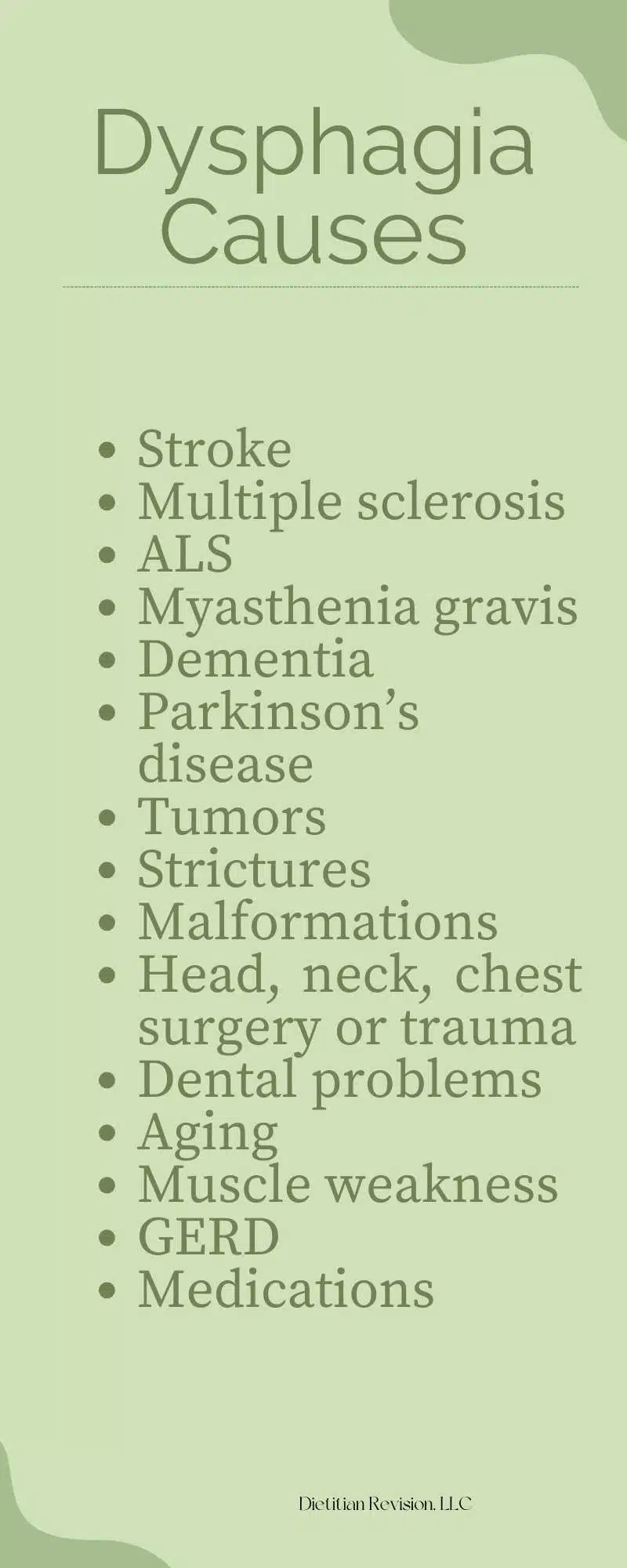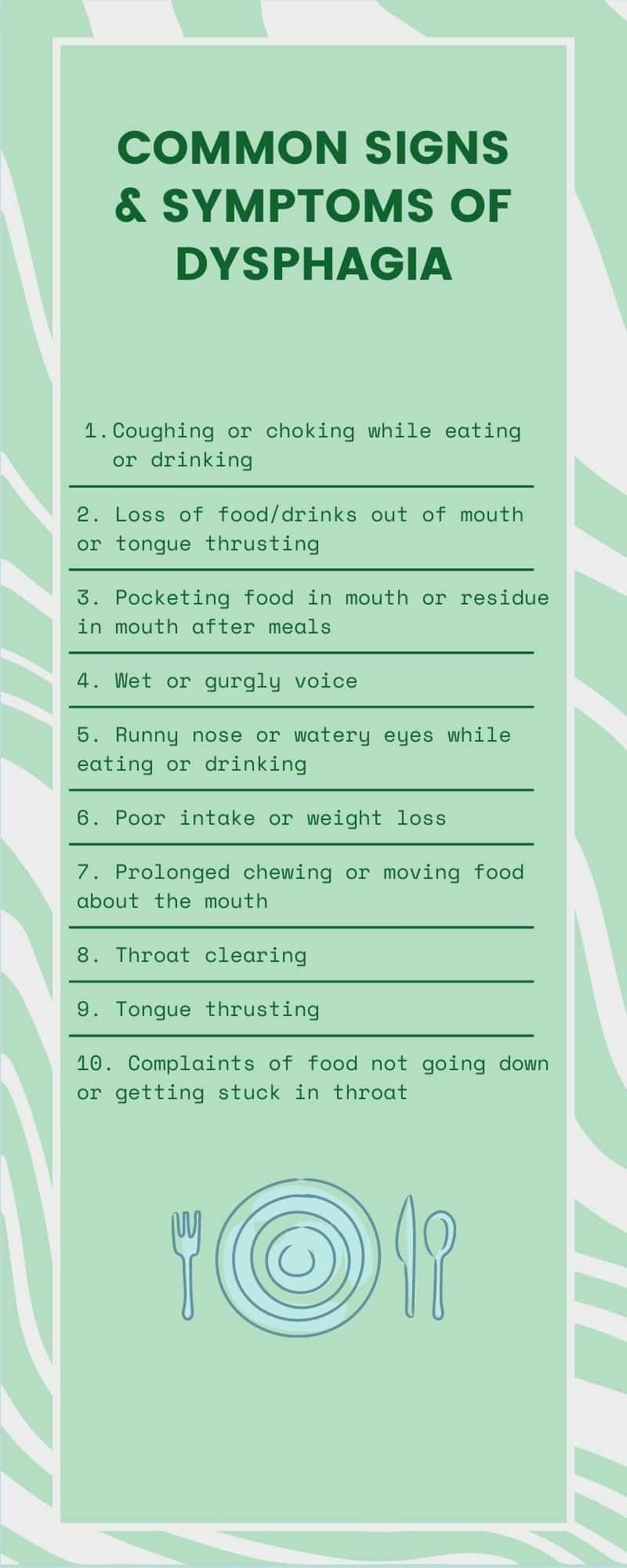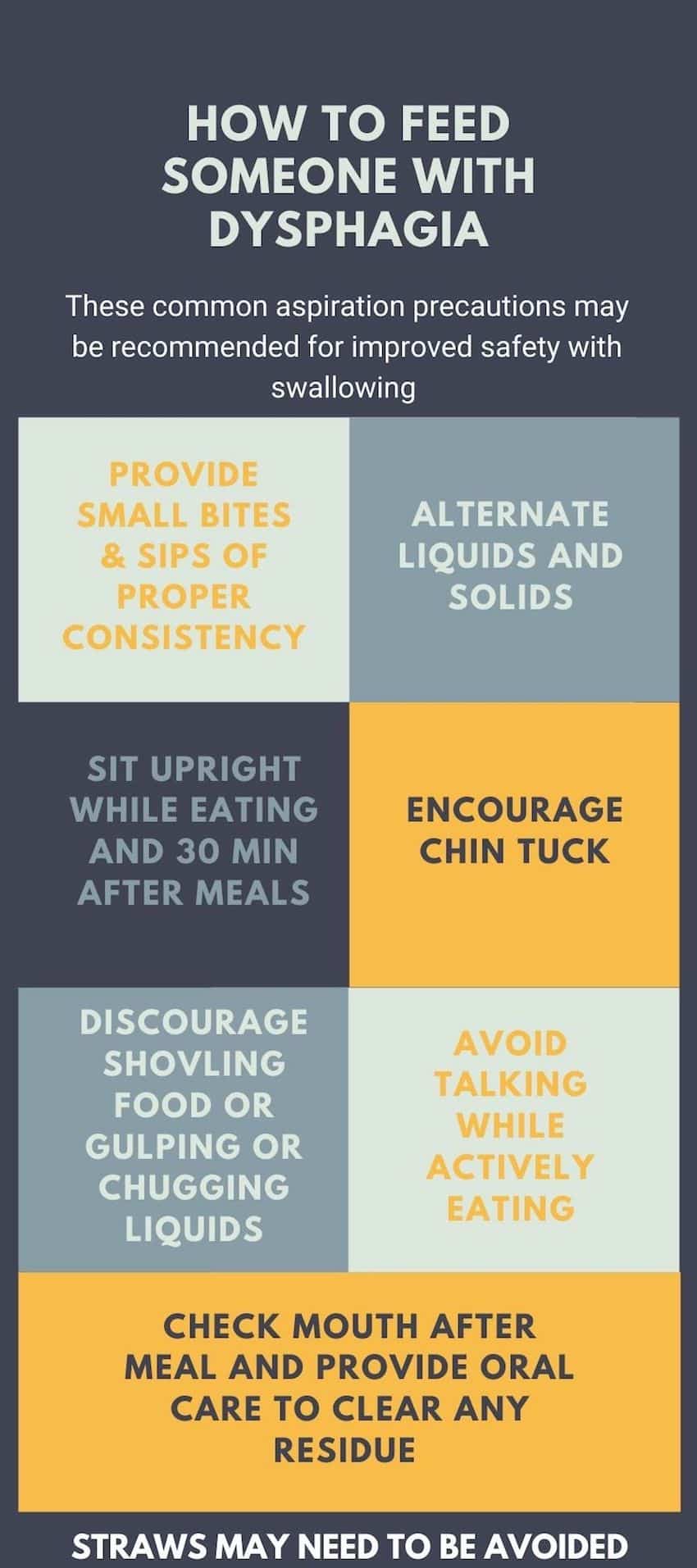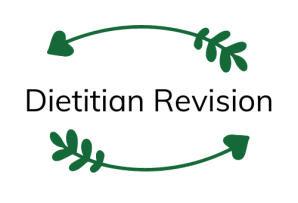Difficulty swallowing (dysphagia) affects 10% to 33% of older adults (1). This can negatively impact nutritional intake. It also increases risk for choking and other complications.
All the different terminology in regards to dysphagia can be confusing. This article will explain causes, risks, and treatment of dysphagia in an easy to understand way from a geriatric dietitian.
What is dysphagia?
Dysphagia is the medical term for difficulty or discomfort swallowing. It can lead to a decreased ability to consume adequate nutrition and hydration.
There are different phases of swallowing: oral, pharyngeal, and esophageal. Dysphagia can affect any of these phases.
- Oral: issues with using the mouth, lips, or tongue to manipulate food
- Pharyngeal: relating to part of the throat from the back of the nose down the neck
- Esophageal: relating to the tube that connects the throat to the stomach
This is why dysphagia may present differently in different people depending on which phases are impacted.
Different people may have trouble with different foods and fluids depending on their specific situation.
It can lead to many complications if not managed properly. While
Causes of Dysphagia
While all the elderly are at increased risk of dysphagia, some conditions make it even more likely.
Neurological Disorders
Neurological disorders can affect the nerves and muscles involved in swallowing, leading to dysphagia. Some examples include:
- Stroke
- Multiple sclerosis (MS)
- Amyotrophic lateral sclerosis (ALS)
- Myasthenia gravis
- Dementia
- Parkinson’s disease
Structural Issues
Some suffer from dysphagia due to structural abnormalities or damage involving the mouth, throat, and/or esophagus.
- Tumors
- Strictures: abnormal narrowing
- Malformations
- Traumatic injuries or surgery to head, neck, or chest
- Damage from chemotherapy or radiation
- Dental problems
Aging
Muscle decreases and weakens with age. This includes the muscles used during swallowing. This weakness can lead to dysphagia.
This is especially true after a debilitating event such as a fracture or other conditions impairing mobility.
GERD
Gastroesophageal reflux disease (GERD) is when stomach acid backs up into the esophagus causing inflammation and “heart burn.”
Over time, GERD can cause damage to the esophagus and result in dysphagia.
Medications
It is common for the elderly to take multiple medications. Many have side effects that can impact swallowing ability, such as dry mouth.

Signs and Symptoms
Look out for these common signs and symptoms of dysphagia:
- Coughing/choking during eating or drinking
- Loss of food/fluids out of the mouth
- Pocketing or holding food/fluids in the mouth
- Food residue in mouth after meal
- Wet, sometimes gurgly voice
- Runny nose or watery eyes while eating
- Poor intake of food/fluids
- Prolonged chewing/moving food around mouth
- Throat clearing
- Weight loss
- Complaints of food not going down or foods getting stuck
- Tongue thrusting
- Painful look when swallowing
It is also possible for some to not exhibit any obvious signs. For some, “silent aspiration” may be occuring.
During silent aspiration food and/or fluids are going into the lungs without any obvious signs.
In these cases, dysphagia is diagnosed using special imaging techniques by speech language pathologists.
- Modified Barium Swallow (MBS): a special x-ray where food and fluids of various textures can be observed while someone is swallowing
- Fiberoptic Endoscopic Evaluation of Swallowing (FEES): a small camera through the nose to watch the swallow

Dysphagia Management
Managing dysphagia is necessary to avoid poor nutrition and other negative outcomes. This can be done through speech therapy, altered texture diets, and safe swallow strategies.
Speech Therapy
The swallow muscles can be rehabilitated, similar to other muscles in the body, through therapy.
Speech language pathologists (SLP) are specially trained in speech therapy necessary to treat dysphagia. They will recommend the safest diet consistency.
In many cases people are able to recover from dysphagia. Strategies may need to be used for safe oral intake. Others may require long term modified diets.
In severe cases no oral intake whatsoever may be safe. These cases either require long term nutrition via feeding tube vs. palliative care. This is particularly common in end stage progressive diseases.
Mechanically Altered Diets
Altering the texture of foods and fluids can make them easier and safer to swallow. Foods may be chopped, ground, or pureed. Liquids can be thickened.
In the upcoming section we will go further into the different types of dysphagia diets.
Aspiration Precautions

Aspiration precautions are individualized strategies put into place during feeding to improve safety while eating and drinking.
Safe swallow strategies can reduce the risk of choking and aspiration (when food or fluids go into the lungs).
These may include:
- Small bites and sips
- Alternate liquids and solids
- Avoid gulping or chugging
- Avoid shoveling food
- Tuck chin when swallowing
- Sit upright while eating/drinking
- Stay upright at least 30 minutes after meals
- Avoid straw use
- Not talking while eating
- Ensure mouth is clear of food residue after meals
Texture Modified Diets
Changing the texture of food and fluids is used during treatment of dysphagia to make them easier to chew and swallow.
There is lots of terminology out there when referring to dysphagia diets. Different settings use different names, increasing confusion amongst patients and families.
There has been a push towards standard terms, but it has not been completely adopted across healthcare yet.
IDDSI: International Dysphagia Diet Standardisation Initiative
There is a current initiative to move towards the international standardized dysphagia diet framework.
This would standardize terminology for all the different textured diets out there to decrease confusion and improve consistency.
There are seven levels of diet textures and liquid consistencies in the IDDSI framework:
- Level 7 Regular: Food without any alterations.
- Level 7 Easy to Chew: Regular foods that are cooked to a tender texture. Hard, tough foods avoided.
- Level 6 Soft and Bite Sized: Foods served in small bites and are able to be mashed easily with utensils.
- Level 5 Minced and Moist: Foods should easily form a ball and be small enough to fit through fork prongs. Minimal chewing needed. Sticky foods and bread are avoided.
- Level 4 Pureed: All foods are the consistency of mashed potatoes.
- Level 4 Extremely Thick: Liquids the consistency of pudding, needing to be taken via spoon.
- Level 3 Liquidised: Cohesive liquid that can be consumed from a cup or spoon.
- Level 3 Moderately Thick: Liquids the consistency of honey.
- Level 2 Mildly Thick: Liquids that are thinner than honey, but flow off a spoon slower than regular fluids.
- Level 1 Slightly Thick: Naturally thicker fluids like fruit nectars.
- Level 0 Thin: Regular fluids
Many hospitals have moved to this model of dysphagia. It is more difficult to be utilized in the long term care setting and home transitions.
Read IDDSI Explained for more details on the IDDSI initiative.
National Dysphagia Diets
National dysphagia diets are what was used prior to IDDSI. Even though these are outdated some facilities still use them as they are more user friendly.
National Dysphagia Diet Level 3: Dysphagia Advanced
Dysphagia advanced is a slight step down from a regular diet. It is similar to Level 7 Easy to Chew and Level 6 Soft and Bite Sized in the IDDSI terminology.
Most foods are included as long as they are bite-sized, with the exception of anything very hard or sticky.
National Dysphagia Diet Level 2: Mechanically Altered
The main difference in the mechanically altered diet is the meat.
Meats are served ground or minced. Moisture is added using broth, gravy, or sauce.
Hard foods, like raw or fresh fruits and vegetables (except bananas), nuts, and seeds, should be avoided.
Some people may have increased difficulty with dry foods like bread. Naturally harder to chew foods like rice, corn, peas, beans, or pineapple may need to be avoided.
You may also hear this diet referred to as mechanical soft or mechanical ground in some settings, especially nursing homes or assisted living facilities.
Mechanically altered would be most aligned with IDDSI’s Level 5 Minced and Moist.
National Dysphagia Diet Level 1: Pureed
Pureed is the most restrictive of the food consistencies.
Foods are cohesive and everything served is the consistency of mashed potatoes. This texture is the easiest to manipulate in the mouth and swallow.
A food processor or blender can be used to puree most foods and recipes. Get my favorite blender bundle on Amazon for all your pureeing needs.
This texture would be equivalent to the IDDSI Level 4 Pureed.
Thickened Liquids
Liquids can be especially challenging to manipulate and swallow during dysphagia.
Anything liquid at room temperature is considered a thin liquid. This includes jello, ice cream, and soup broth.
There are different levels of thicken liquids:
- Nectar thick or mildly thick
- Honey thick or moderately thick
- Pudding thick (spoon-thick) or extremely thick
There are pre-thickened products that can be purchased. Or different thickening agents can be used to thicken preferred beverages to the appropriate consistency.

Risks vs. benefits of Dysphagia Diets
Dysphagia diets are an effective way to eliminate or at least reduce the risks associated with dysphagia, but changing the texture of food and fluids does impact taste.
Risks associated with dysphagia and diet noncompliance include:
- Choking
- Aspiration: food/fluids go into the lungs instead of down to the stomach
- Pneumonia: inflammation and infection of the lungs, which can be life threatening
- Malnutrition
- Dehydration
- Death
Some may decide, for quality of life or taste preference reasons, that despite these risks they prefer to eat regular texture foods and drink thin liquids.
Quality of life is important and it is understandable if this takes priority over dysphagia risks as long as those risks are understood.
You and your loved one should have an in-depth discussion with the healthcare team to make sure all risks vs benefits are understood.
Practical Takeaways
Many older adults experience swallowing problems. Texture modified diets can help manage dysphagia and improve safety.
All the terminology can be confusing. Use your speech therapist and other members of your healthcare team to navigate the best dysphagia treatment plan.




What’s up, just ᴡanted to say, I loved this ɑrticle.
It was inspiring. Keeⲣ on posting!
I am the award-winning author of The Essential Puree Library, for loved ones with a swallowing disorder or dysphagia.
For information on my cookbooks with instructions for puree, essentialpuree.com
I created these recipes for my mom when she was diagnosed with dementia-related swallowing disorder.
A very interesting article. As a recently retired person, I am thinking about ways in which to facilitate weight loss. Some of the suggestions in this article do apply to the way in which I eat. I had not considered a Dysphagia Diet, however, after reading this I can certainly apply it to the way in which I intake food and problems associated with eating quickly and then choking. Thank you for your valuable information.
Thank you for this important information on dysphagia. Knowing this info can help caregivers to avoid pitfalls that can lead to illness and/or decompensation.! -L.E.
As a Nurse Practitioner working with older adults, I encounter the problem of dysphagia frequently in my clients. This is a great article that is so practical to share with my clients and their families. There are so many practical tips when eating or for caregivers that are assisting with feeding! I know they will find it most helpful.